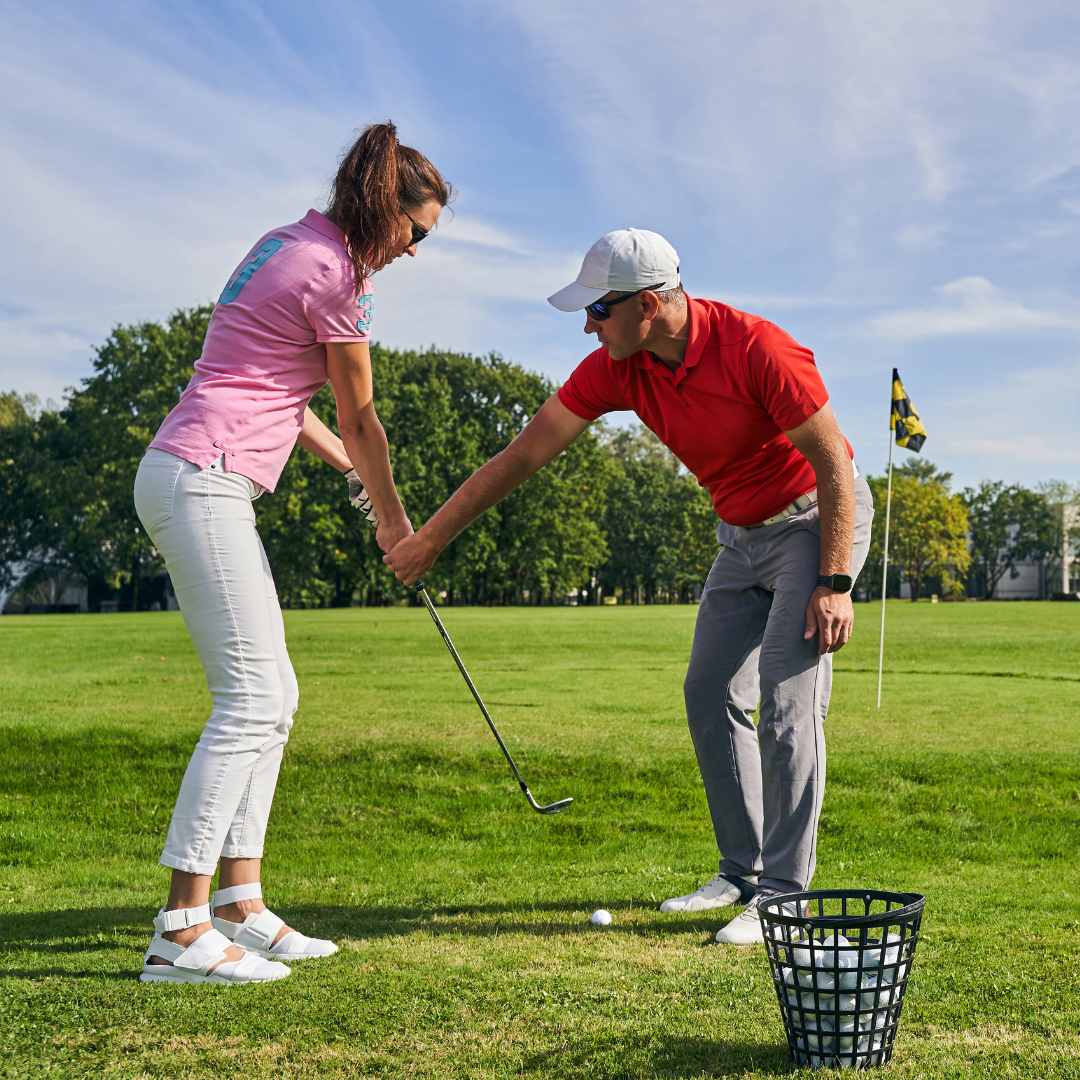
25 Best Golf Tips for Beginners
25 Best Golf Tips for Beginners
Mastering the Greens: In-Depth Best Golf Tips for Beginners
Embarking on your golfing journey? Golf For Beginners Academy has you covered with a detailed guide featuring essential tips tailored for novice players. Let’s dive into each section for a comprehensive understanding of golf tips for beginners.
The Fundamentals of Golf - Section 1
Proper Grip and Stance: Achieve a strong foundation by mastering your grip and stance. A neutral grip and balanced stance provide stability, ensuring a controlled and powerful swing.
Understanding Club Selection: Learn the basics of club selection based on the distance and shot requirements. Familiarize yourself with the different types of clubs and their specific uses.
Swing Basics: Focus on a fluid and balanced swing. Practice your backswing, downswing, and follow-through to create a consistent and efficient motion that improves accuracy.
Ball Positioning: Understand the importance of proper ball positioning for different shots. Master the alignment of the ball in your stance to optimize trajectory and contact.
Developing a Pre-Shot Routine: Establish a pre-shot routine to enhance your focus and consistency. This routine can include visualizing your shot, checking alignment, and taking a few practice swings.
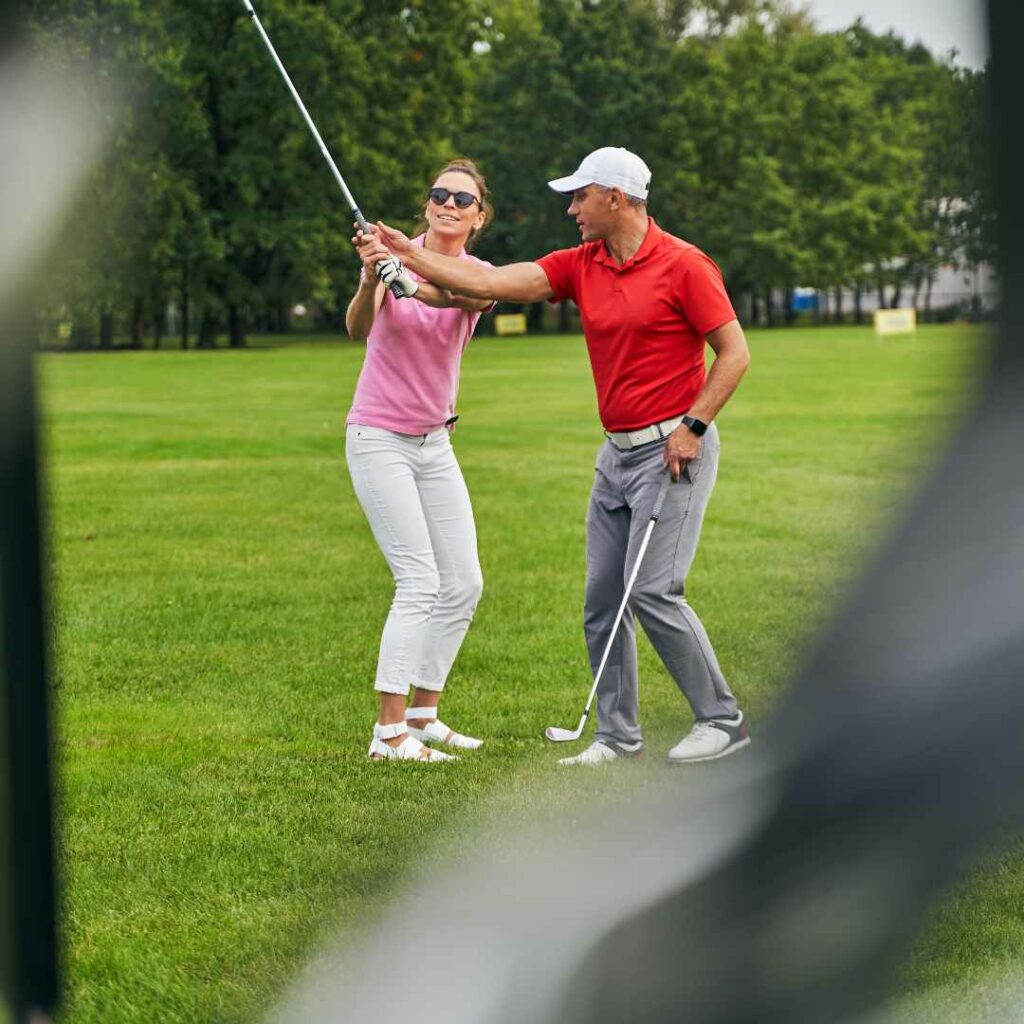
Want to learn more about the swing?
Listen to our podcast!
Mastering the Short Game - Section 2
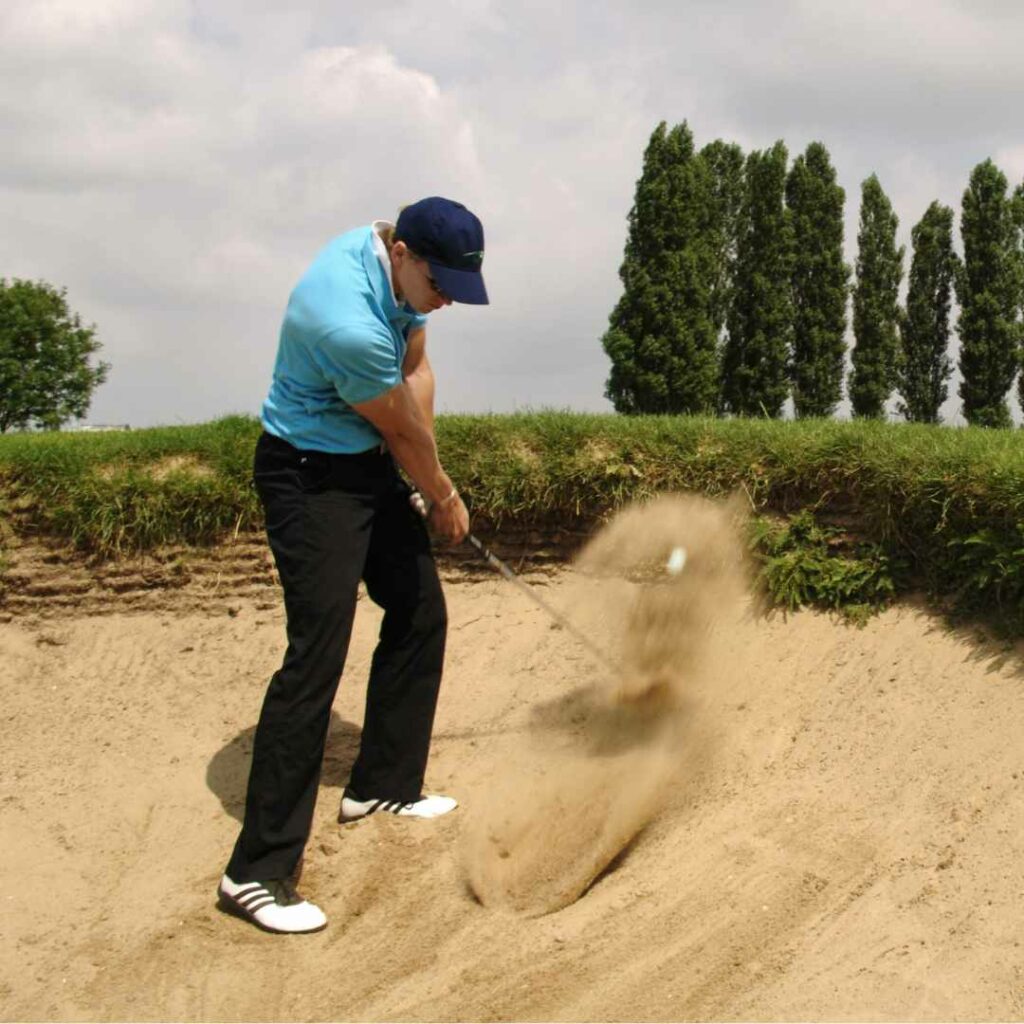
Putting Precision: Hone your putting skills by focusing on distance control, alignment, and a smooth stroke. The short game is often where strokes can be saved or lost.
Chipping Techniques: Practice various chipping techniques for shots around the green. Learn how to control trajectory and spin to get the ball close to the hole.
Pitching Perfection: Develop your pitching skills for shots that require more loft. Mastering the pitch shot is crucial for navigating obstacles and landing the ball softly on the green.
Bunker Play: Understand the fundamentals of bunker play, including the proper setup, swing, and strategy for getting out of sand traps efficiently.
Reading Greens: Improve your ability to read greens by understanding the slope, grain, and nuances of the putting surface. Accurate green reading is key to successful putting.
Course Management Strategies - Section 3
Playing Within Your Abilities: Recognize your skill level and play within your abilities. Avoid unnecessary risks and focus on making consistent shots to improve overall performance.
Strategic Club Choices: Develop a strategic approach to club selection based on the layout of the course. Choose clubs that allow you to navigate hazards and position yourself for the next shot.
Understanding Par: Familiarize yourself with the concept of par and set realistic expectations. Aim to play within or slightly above par, focusing on steady improvement.
Pace of Play: Respect the pace of play on the course. Be mindful of your group’s speed, maintain a reasonable pace, and be ready for your turn to keep the game enjoyable for everyone.
Course Awareness: Stay aware of the course layout and potential challenges. Knowing where hazards, bunkers, and doglegs are located helps you plan and execute more successful shots.

Mental Game and Focus - Section 4

Maintaining a Positive Mindset: Cultivate a positive attitude on the course. Overcome challenges with resilience, focusing on learning from each shot rather than dwelling on mistakes.
Visualization Techniques: Harness the power of visualization to enhance your performance. Picture successful shots in your mind before executing them to boost confidence.
Breathing and Relaxation: Incorporate deep breathing and relaxation techniques to stay calm under pressure. Managing stress enhances your ability to make clear decisions on the course.
Handling Setbacks: Learn to bounce back from setbacks and mistakes. Resilience is a crucial trait in golf, and the ability to recover from a bad shot is essential for long-term success.
Staying Present on the Course: Practice staying in the moment during your round. Avoid dwelling on past shots or worrying about future ones. Focus on the task at hand to improve overall performance.
Continuous Improvement and Resources - Section 5
Effective Practice Habits: Maximize your practice sessions with focused drills and exercises. Target specific areas of your game that need improvement and track your progress over time.
Golf Lessons and Professional Guidance: Consider taking golf lessons from a certified instructor. Professional guidance helps identify areas for improvement and provides personalized feedback.
Utilizing Technology: Leverage golf technology, such as swing analysis apps and launch monitors, to gain insights into your swing mechanics and track performance metrics.
Joining a Golf Community: Connect with other golf enthusiasts by joining a local golf community or club. Networking with fellow players provides opportunities for friendly competition and shared learning.
Staying Informed: Stay informed about the latest trends, techniques, and equipment in the golfing world. Subscribe to golf publications, follow reputable online resources, and attend golf expos for continuous learning.
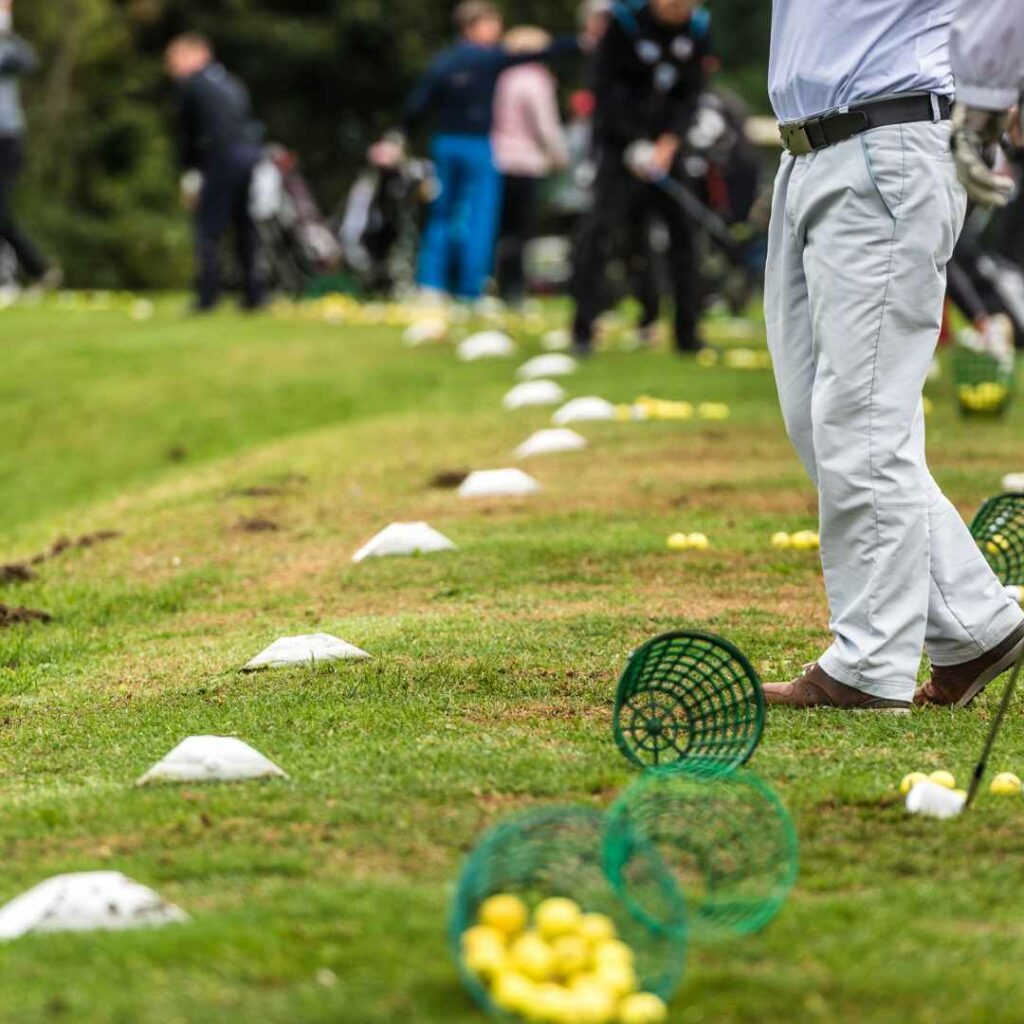
Ready to Take the Next Step? ⛳️
If you’re eager to dive deeper into golf’s intriguing world and master the ins and outs of the game, look no further than our “Golf For Beginners – The Ultimate Starter Guide.” Whether you’re a newbie or just brushing up on your skills, this online course has something for everyone.
⛳️ Discover the Ultimate Golf Starter Guide Right Here ⛳️
Conclusion on the 25 Best Golf tips for beginners
Congratulations! You’ve navigated through our comprehensive guide on golf tips for beginners. Remember, mastering golf is a continuous journey of improvement. Apply these tips, stay dedicated to your practice, and enjoy the evolving experience of becoming a skilled and confident golfer. Golf For Beginners Academy is here to support you every step of the way. Happy golfing!
Did You Like The 25 Best Golf Tips For Beginners?
If you want more detailed help with you game of golf, and specifically about the short game of golf, our partner-portal called World Of Short Game deliver great content for all short game related topics. Click here to visit World Of Short Game.
And if you live in Denmark, never hesitated to reach out to Danish Golf Academy for help with any part of your game.

5 Simple Tips on How to Hit a Golf Ball Further
5 Simple Tips on How to Hit a Golf Ball Further
Unleash Your Swing and learn How to Hit a Golf Ball Further
Welcome to Golf For Beginners Academy, where we’re about to unravel the secrets of How to Hit a Golf Ball Farther! Ready to maximizing your distance off the tee. In this guide, we’ll explore five straightforward yet highly effective tips on how to hit a golf ball further. Let’s power up your swing!
1 - Optimize Your Stance for Power
Before you embark on the journey to unlock more power in your golf shots, it’s essential to establish a rock-solid foundation through the optimization of your stance. In this section, we’ll delve into the intricacies of achieving the ideal golf stance, emphasizing balance, weight distribution, and the critical role it plays in generating power and stability in your swing.
The Significance of a Proper Stance: Your golf stance serves as the launchpad for your swing, and its correct configuration is paramount to harnessing maximum power. By optimizing your stance, you set the stage for a dynamic and efficient golf swing. Let’s break down the key elements that contribute to an effective stance.
Shoulder-Width Foundation: Begin by positioning your feet at shoulder width apart. This stance width provides a stable base and balance, ensuring you can maintain control throughout your swing. Visualize your stance as the bedrock upon which your golf swing masterpiece will be built.
Even Weight Distribution: Once you’ve established your shoulder-width foundation, distribute your weight evenly between both feet. Balance is key to a powerful and controlled swing. Avoid favoring one side or the other, as it can lead to instability and inconsistent shots. Think of your stance as a perfectly balanced scale, ready to weigh in on the power equation.
Knee Flexion for Dynamic Power: Slightly flex your knees to add an element of dynamic power to your stance. This knee flexion serves as a coiled spring, ready to release energy during your downswing. Imagine the potential energy stored in your legs, waiting to be converted into clubhead speed and distance.
Spine Tilt for Optimal Alignment: To complete your stance optimization, tilt your spine away from the target ever so slightly. This slight tilt helps align your body correctly and prepares your shoulders for a powerful coil during the backswing. Visualize your spine as the axis around which your swing will rotate, enabling you to generate torque and power.
Stability and Balance: As you adopt this balanced and optimized stance, focus on maintaining stability and balance throughout your swing. Keep your weight centered, your knees flexed, and your spine tilted. These elements work in harmony to provide a stable and powerful foundation for your golf swing.
Practice and Consistency: Achieving a proper stance requires practice and consistency. Spend time at the driving range honing your stance, ensuring it becomes second nature.
In conclusion, optimizing your stance is the foundational step in your journey to unlocking maximum power in your golf shots. Think of it as the canvas upon which you’ll paint your golfing masterpiece. Embrace the principles of shoulder-width foundation, even weight distribution, knee flexion, and spine tilt. With the right stance, you’ll experience a more powerful and stable swing, translating into longer and more controlled shots on the golf course.

2 - Master the Hip Rotation
Achieving maximum distance in your golf shots goes beyond upper body strength; it involves mastering the art of hip rotation. In this section, we will explore the critical role hip engagement plays in transferring energy and increasing clubhead speed, helping you unleash the full potential of your swing.
Understanding the Importance of Hip Rotation: Hip rotation is a fundamental component of generating power in your golf swing. When you initiate your downswing, it’s essential to allow your hips to rotate smoothly. This rotational movement acts as a powerhouse, transferring energy from your lower body to the club. Think of your hips as the engine driving your swing, and mastering this aspect will lead to increased clubhead speed and, consequently, longer shots.
Initiating the Downswing: The proper sequence of your swing involves the hips initiating the downswing. As you transition from the backswing to the downswing, focus on starting the movement with your hips. This rotational action sets the tone for the rest of your swing and ensures that you harness the energy generated by your lower body effectively.
Hip Rotation Dynamics: Effective hip rotation is not about simply turning your hips; it’s about achieving a balanced and synchronized movement. Ensure that your hip rotation is gradual and controlled, avoiding any jerky or forced movements. Visualize a smooth pivot around your spine, allowing your hips to lead the way and follow through seamlessly.
Maintaining Posture and Balance: While emphasizing hip rotation, it’s crucial to maintain proper posture and balance throughout your swing. Keep your spine relatively straight and your weight evenly distributed between your feet. This stability allows you to control the rotational forces generated by your hips and channel them into your clubhead speed. Balance is the key to accuracy and control, which are essential in addition to distance.
The Role of Core Strength: Developing core strength is vital for optimizing hip rotation. A strong core provides stability and control during your swing, allowing you to harness the energy generated by your hips more effectively. Incorporate core-strengthening exercises into your fitness routine to enhance your overall golf performance.
In conclusion, mastering hip rotation is a pivotal aspect of unlocking explosive power in your golf swing. Embrace the concept of your hips as the engine driving your swing’s energy. Practice gradual, controlled hip rotation to ensure a balanced and synchronized movement. With proper hip engagement, you’ll experience increased clubhead speed, leading to longer and more powerful golf shots.
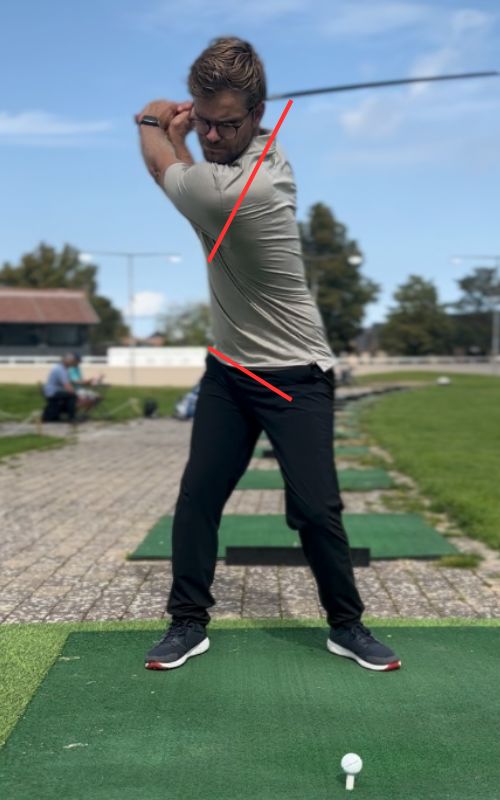
3 - Generate Lag with Wrist Action
Creating and harnessing lag in your golf swing is a secret weapon for adding significant distance to your shots. In this section, we’ll delve into the intricacies of wrist action, teaching you how to generate and maintain lag effectively for a more powerful and controlled downswing.
The Art of Lag Creation: Lag refers to the angle formed between the clubshaft and your lead forearm during the downswing. To generate lag, initiate your swing with a slight wrist hinge during the backswing. This hinge allows you to store energy like a coiled spring, ready to be unleashed for explosive impact. Think of it as winding up before delivering a powerful punch. The key is to maintain this wrist hinge until the last possible moment in your downswing.
Timing is Everything: One of the critical aspects of lag creation is the timing of your wrist release. Delay releasing your wrists until the very last moment before impact. This delayed release is what makes lag such a potent force in your swing. As you transition from the top of your backswing to the downswing, maintain that angle between your clubshaft and forearm, resisting the urge to prematurely release your wrists. Picture it as holding back a loaded slingshot, with the clubhead as your projectile.
Storage and Release of Energy: The beauty of lag lies in its ability to store and release energy explosively. As you maintain the hinge in your wrists, you’re storing potential energy that can be transferred to the golf ball at impact. When you finally release your wrists, that stored energy is unleashed, resulting in faster clubhead speed and greater distance. It’s akin to snapping a whip—a controlled and powerful release that propels the ball down the fairway with added velocity.
Practice and Patience: Developing the skill of generating lag with wrist action requires practice and patience. Start by working on your wrist hinge during your backswing, ensuring it’s gradual and not forced. Progress to your downswing, concentrating on delaying the release. Use practice drills and swing aids to reinforce this skill. It’s essential to strike a balance between generating lag and maintaining control, so practice is key to refining your technique.
Seeking Professional Guidance: For a more in-depth understanding of generating lag, consider seeking guidance from a golf instructor. They can provide personalized feedback, drills, and exercises to help you master this crucial aspect of your swing. Additionally, video analysis can offer valuable insights into your wrist action, enabling you to make necessary adjustments.
In conclusion, generating and maintaining lag with wrist action can significantly enhance your golf swing’s power and distance potential. Embrace the concept of lag as a way to store and release energy explosively at impact. Remember that perfecting this skill takes time and dedication, but the rewards in terms of longer and more controlled shots are well worth the effort.
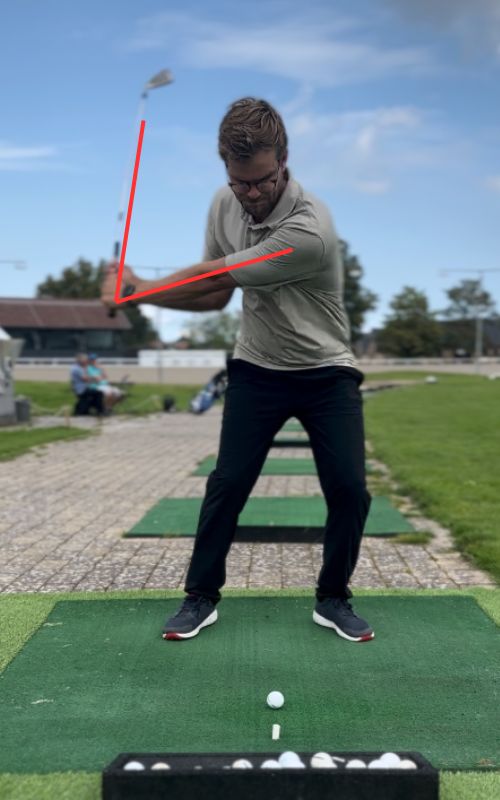
4 - Perfect Your Timing and Tempo
Mastering the art of hitting a golf ball further goes beyond sheer power; it hinges on achieving the perfect blend of timing and tempo. Let’s dive deep into this crucial aspect of your swing, exploring techniques to help you harness your full potential for longer shots.
The Art of Controlled Tempo: As a beginner, it’s tempting to swing forcefully, believing that raw power alone will send the ball soaring. However, the truth lies in controlling your tempo. Rushing the downswing often leads to inconsistencies and shorter drives. Instead, focus on a smooth, well-timed transition between your backswing and downswing. Imagine a pendulum, swinging back and forth with a balanced rhythm. This analogy reflects the controlled tempo you should aim for in your golf swing.
Balance and Rhythm: Achieving the perfect tempo involves maintaining balance throughout your swing. A proper weight shift from your back foot to your front foot is crucial. Visualize the transfer of your weight, like a graceful dance move, ensuring you maintain your center of gravity and rhythm. This balanced, rhythmic motion is the key to unlocking your optimal clubhead speed, which directly translates into those coveted longer drives.
Mental Game: Your mental approach plays a significant role in mastering timing and tempo. Stay relaxed and focused during your swing, free from any unnecessary tension or anxiety. Practice mindfulness and visualization techniques to enhance your mental game. Visualize the ideal swing in your mind before stepping up to the ball, reinforcing the importance of a controlled and smooth tempo in your subconscious.
Practice and Patience: Achieving a consistent and controlled tempo takes practice and patience. Dedicate time to the driving range to work on your swing mechanics. Consider seeking guidance from a golf instructor to fine-tune your tempo. Understand that it’s a gradual process, and improvements will come with dedication and repetition.
5 - Choose the Right Equipment
The right equipment can be your secret weapon for hitting a golf ball further. Selecting the appropriate gear tailored to your unique swing characteristics is crucial. In this section, we’ll explore the nuances of golf equipment selection and custom fitting, unveiling the key to unlocking your distance potential.
Driver Loft and Shaft Flex: Your driver plays a pivotal role in maximizing distance off the tee. To optimize your drives, ensure your driver has the appropriate loft and shaft flex for your swing speed. A higher loft is ideal for slower swing speeds, as it imparts more backspin and lift on the ball, helping it stay in the air longer. Conversely, if you possess a faster swing speed, a lower loft can help reduce spin for added distance. The shaft flex should match your swing tempo and strength. A more flexible shaft can generate more clubhead speed for those with slower tempos, while a stiffer shaft suits faster swingers. Custom fitting your driver, under the guidance of a professional, can fine-tune these critical aspects to suit your game perfectly.
Club Custom Fitting: Custom fitting is a game-changer when it comes to optimizing your distance potential. It involves tailoring your clubs to match your unique swing characteristics, body posture, and physical attributes. A custom fitting session typically assesses factors such as club length, lie angle, grip size, and more. This meticulous process ensures that each club in your bag complements your swing, resulting in improved accuracy and distance. Many golf retailers and professionals offer custom fitting services, providing you with the opportunity to invest in equipment that truly suits your game.
Ball Selection: Don’t underestimate the role of the golf ball in maximizing your distance. Different golf balls offer varying levels of spin and compression. Consider experimenting with different ball types to find the one that aligns with your swing speed and desired ball flight. A golf ball that matches your game can significantly impact your shot distance and overall performance.
In conclusion, selecting the right equipment and custom fitting your clubs are integral components of hitting a golf ball farther. Pay meticulous attention to your driver’s loft and shaft flex, explore the benefits of club custom fitting, and experiment with different golf balls. By fine-tuning your gear to match your unique characteristics, you’ll unlock your full potential for maximum distance on the golf course.
Want to learn more about how to play golf? ⛳️
If you’re eager to dive deeper into golf’s intriguing world and master the ins and outs of the game, look no further than our “Golf For Beginners – The Ultimate Starter Guide.” Whether you’re a newbie or just brushing up on your skills, this online course has something for everyone.
⛳️ Discover the Ultimate Golf Starter Guide Right Here ⛳️
Conclusion on How to Hit a Golf Ball Further for Beginners
Hitting the ball far can be exhilarating, but is it essential for beginner golfers? While distance is a valuable asset, focus on mastering fundamental techniques first. As your skills grow, incorporate these tips gradually. Remember, accuracy and consistency trump sheer power for beginners. Enjoy the journey of improvement and the occasional long drive will become an added bonus to your game. Stay tuned to Golf For Beginners Academy for more valuable insights to enhance your golfing journey. Happy swinging!
Did you like the article "How to Hit a Golf Ball Further"?
If you want more detailed help with you game of golf, and specifically about the short game of golf, our partner-portal called World Of Short Game deliver great content for all short game related topics. Click here to visit World Of Short Game.
And if you live in Denmark, never hesitated to reach out to Danish Golf Academy for help with any part of your game.
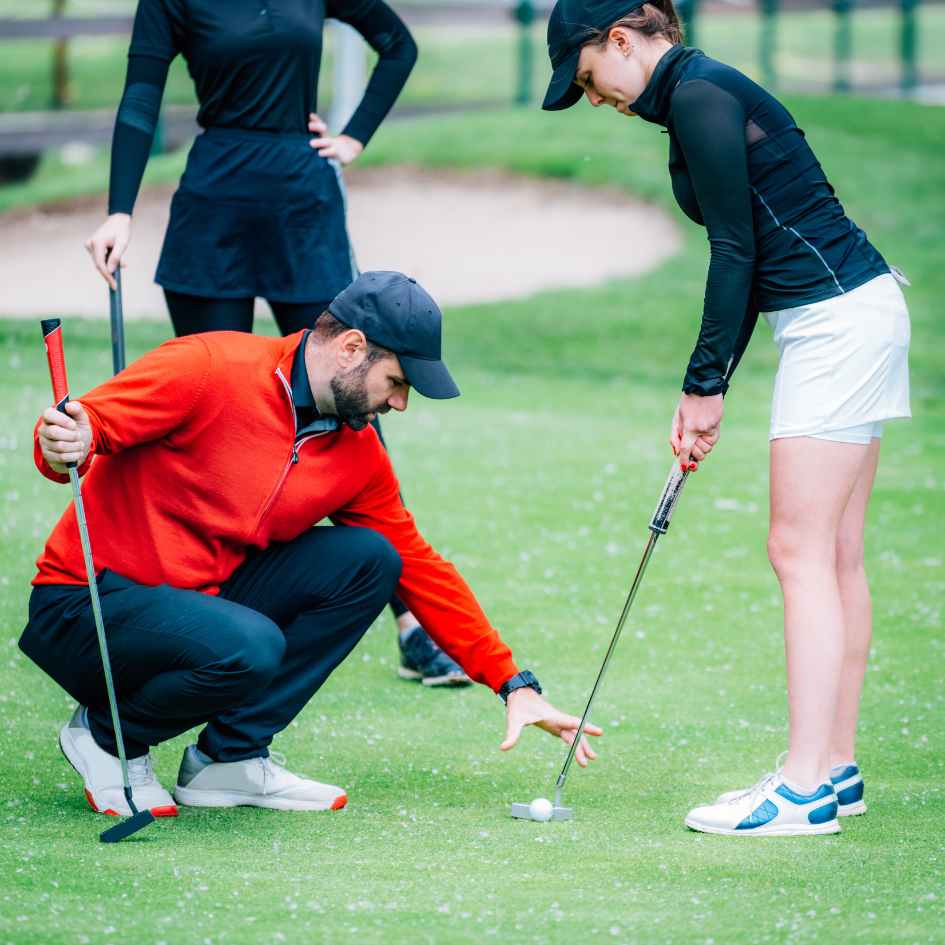
9 Essential Golf Putting Tips for Beginners
9 Essential Golf Putting Tips for Beginners
Perfecting Your Putting as a Beginner
Welcome to Golf For Beginners Academy, where we guide novice players through the basics of golf. Today, we’re focusing on an integral aspect of the game – putting. For beginners, mastering the putt is key to lowering scores and enjoying the game to the fullest. Let’s delve into essential golf putting tips tailored just for you.
Golf Putting Tips for Beginners
Grip and Stance: Start with a comfortable grip, neither too tight nor too loose. Adopt a shoulder-width stance for stability. This sets the foundation for a controlled and consistent putting stroke.
Eye Alignment: Ensure your eyes are directly over the ball. This alignment enhances your perception of the putting line and helps you visualize the correct path to the hole.
Smooth Putting Stroke: Develop a smooth, pendulum-like putting stroke. Avoid unnecessary wrist movements and let the shoulders control the motion. A steady stroke promotes accuracy and distance control.
Distance Control: Mastering distance control is crucial. Spend time practicing putts of various lengths to develop a feel for the required strength. Consistent distance control is a game-changer on the green.
Read the Green: Analyze the slope and break of the green before making your putt. Look for subtle undulations that can influence the ball’s path. Reading the green is a skill that improves with practice and observation.
Practice Putting Drills: Incorporate putting drills into your practice routine. Focus on short putts to build confidence and gradually extend the distance as your skills improve. Consistent practice hones your putting prowess. Check out this article for our favorite putting-drills for beginners!
Putter Choice: Experiment with different putters to find one that feels comfortable for you. The right putter can enhance your control and confidence on the green. Consider seeking advice from a golf professional to find the perfect fit.
Maintain a Routine: Develop a pre-putt routine to create consistency in your setup and stroke. This routine could include a few practice swings, checking the line, and aligning the putter face to your intended target.
Stay Calm Under Pressure: Putting often determines the outcome of a hole. Practice keeping a calm mindset, especially when facing pressure situations. Relax, trust your skills, and execute your stroke with confidence.
Time to get to work!
Congratulations! You’re now equipped with essential golf putting tips designed specifically for beginners. Put these insights into practice, and watch as your putting skills improve, contributing to a more enjoyable and successful golfing experience. Stay tuned to Golf For Beginners Academy for more valuable tips to enhance your game. Happy putting!
Ready to become a better golfer? ⛳️
You’ve learned about the putting game of golf. If you’re eager to dive deeper into golf’s intriguing world and master the ins and outs of the game, look no further than our “Golf For Beginners – The Ultimate Starter Guide.” Whether you’re a newbie or just brushing up on your skills, this online course has something for everyone.
⛳️ Discover the Ultimate Golf Starter Guide Right Here ⛳️
Did You Like These 9 Essential Golf Putting Tips for Beginners?
If you want more detailed help with you game of golf, and specifically about the short game of golf, our partner-portal called World Of Short Game deliver great content for all short game related topics. Click here to visit World Of Short Game.
And if you live in Denmark, never hesitated to reach out to Danish Golf Academy for help with any part of your game.

How to Hit a Golf Chip Shot for Beginners
How to Hit a Golf Chip Shot for Beginners
Perfecting the Basics: A Beginner's Guide to Mastering Chip Shots in Golf
Welcome to Golf For Beginners Academy, where we simplify the art of golf for novice players. Today, we’re unveiling a beginner-friendly guide on executing chop shots with precision. These fundamental tips will enhance your control and bring you one step closer to achieving those dreamy shots around the green.
Unlocking Success: Beginner-Friendly Tips for Chip Shots
Perfecting your chip shot is crucial for close-to-the-hole success. Let’s dive into these beginner-friendly tips to make your contact with the ball better than ever.
Build the Right Foundation: Start with a setup tailored to your shot. Place the ball under your sternum, hands just inside the left thigh, and weight distributed 55% on the left foot and 45% on the right. This ensures proper shaft lean for smooth club motion.
Which Way Are You Swinging? Swing the club along the established plane. Coordinate wrist movements and body rotation to match the swing plane for a seamless backswing.
An Open Face is a Happy Face: Allow the clubface to open during the backswing. An open clubface promotes a gliding motion over the ground, ensuring a smoother impact and release.
Let It Go, Let It Go!: In the downswing, permit your hands and wrists to move freely. Avoid forcing the club; let it follow its natural flow for a more controlled impact.
Your Release Needs Backup: Support the wrist release with a rotation of the upper body. A coordinated motion of the upper and lower body in the follow-through ensures a balanced and controlled release.
Up Up Up: Move certain parts of your body upward during the motion, especially the grip of the club. Ensure your head, body, and shoulders extend slightly, allowing the clubhead to move downward while the grip moves upward.
You’ve Got to Go Forward!: In the finish position, shift about 90% of your weight onto the front foot. This improves control over the club’s contact point and ensures a stable finish.
How Far Are You Going?: Maintain consistent swing lengths in both backswing and follow-through. An equal-length backswing and follow-through enhance low point control and distance accuracy.
Please Don’t Kill the Bird!: Grip the club with the right pressure. Experiment with different grip pressures (1 to 10 scale) to find the one that allows a natural release and consistent impact conditions.
Yes - Lets go!
Congratulations! You’ve just unlocked the secrets to mastering chip shots in golf. Practice these beginner-friendly tips consistently, and you’ll soon find yourself confidently navigating the short game. Happy chipping!
Ready to Take the Plunge? ⛳️
You’ve learned about how to master the chip shot. If you’re eager to dive deeper into golf’s intriguing world and master the ins and outs of the game, look no further than our “Golf For Beginners – The Ultimate Starter Guide.” Whether you’re a newbie or just brushing up on your skills, this online course has something for everyone.
⛳️ Discover the Ultimate Golf Starter Guide Right Here ⛳️
Did you like How to Hit a Golf Chip Shot for Beginners?
If you want more detailed help with you game of golf, and specifically about the short game of golf, our partner-portal called World Of Short Game deliver great content for all short game related topics. Click here to visit World Of Short Game.
And if you live in Denmark, never hesitated to reach out to Danish Golf Academy for help with any part of your game.

Mastering the Basics: How to Grip a Golf Club Correctly for Beginners
How to Grip a Golf Club Correctly for Beginners
Mastering the Basics
Welcome to Golf For Beginners Academy, where we’re committed to helping aspiring golfers like you tee off on the right foot! Today, we’re diving into a fundamental aspect of the game that every beginner needs to get a grip on – literally. In this guide, we’ll explore the art of holding a golf club correctly, ensuring you set the stage for a solid swing and an enjoyable golfing journey.
Understanding the Importance of a Proper Grip
The foundation of a successful golf swing starts with the grip. A correct grip not only influences your control over the club but also impacts the trajectory, accuracy, and power of your shots. So, let’s get started on the path to a great golf grip.
Getting a Hold of It – Step by Step:
Understanding the Basics: Before diving into the nitty-gritty, let’s establish the basics. The grip consists of the hands – the lead hand (left hand for right-handed golfers) and the trail hand (right hand for right-handed golfers).
Positioning the Lead Hand: Begin by placing the club in the fingers of your lead hand, not the palm. The handle should run diagonally across the fingers, with the grip extending from the base of your pinkie to the middle joint of your index finger. This creates the foundation for control and precision.
Adding the Trail Hand: With the lead hand in position, bring in the trail hand. Overlap the fingers of the trail hand with the spaces between the fingers of the lead hand. Ensure that both hands work together in harmony, fostering unity and control throughout your swing.
Checking Knuckle Alignment: A quick check to ensure you’re on the right track – your lead hand’s knuckles should be visible, forming a “V” with the thumb and index finger. This helps in creating a square clubface at impact.
Balancing Grip Pressure: Find the sweet spot when it comes to grip pressure. Too tight, and you risk tension in your swing; too loose, and control becomes elusive. Aim for a firm yet relaxed grip – think of holding a small bird; tight enough not to let it escape, but gentle enough not to harm it.
Common Mistakes to Avoid:
- Death Grip: Avoid squeezing the life out of the club. A relaxed grip promotes fluidity in your swing.
- Faulty Finger Placement: Ensure the handle runs through the fingers, not cradled in the palms.
- Inconsistent Hand Positioning: Maintain a consistent grip from shot to shot for stability and control.
Conclusion
Congratulations! You’ve just taken the first step toward mastering your golf game by learning how to grip a golf club correctly. Practice this fundamental skill consistently, and you’ll soon find yourself making more confident and controlled swings on the course. Stay tuned to Golf For Beginners Academy for more valuable insights to enhance your golfing journey. Happy swinging!
Ready to Take the Next Step? 
You’ve learned about the grip, good job! If you’re eager to dive deeper into golf’s intriguing world and master the ins and outs of the game, look no further than our “Golf For Beginners – The Ultimate Starter Guide.” Whether you’re a newbie or just brushing up on your skills, this online course has something for everyone.
⛳️ Discover the Ultimate Golf Starter Guide Right Here ⛳️

How do I improve my golf swing? 25 Checkpoints
How do I improve my golf swing? 25 Checkpoints
Strategies on How to Improve Your Golf Swing
Welcome to Golf For Beginners Academy, where we unravel the mysteries of refining your golf swing. If you find yourself pondering the question, “How do I improve my golf swing?” – you’re in the right place. In this detailed guide, we’ll delve into a variety of strategies to enhance your swing and, consequently, elevate your overall golf performance.
Understanding the Mechanics: The Foundation of Improvement
To improve your golf swing, it’s essential to understand the foundational mechanics that contribute to a successful and consistent motion.
Grip Refinement: Start by evaluating and refining your grip. A proper grip establishes control and allows for a more natural release of the clubhead.
Posture Assessment: Analyze your posture during setup. Ensure a balanced and athletic stance, promoting better weight distribution and stability throughout the swing.
Alignment Precision: Check your alignment regularly. Misalignment can lead to inaccurate shots, so ensuring proper alignment is a fundamental step in refining your golf swing.
Mastering the Takeaway: Focus on a smooth and controlled takeaway. A well-executed takeaway sets the stage for the entire swing sequence.
Balancing Weight Transfer: Practice a seamless weight transfer during your swing. A balanced shift from backswing to downswing contributes to power and accuracy.
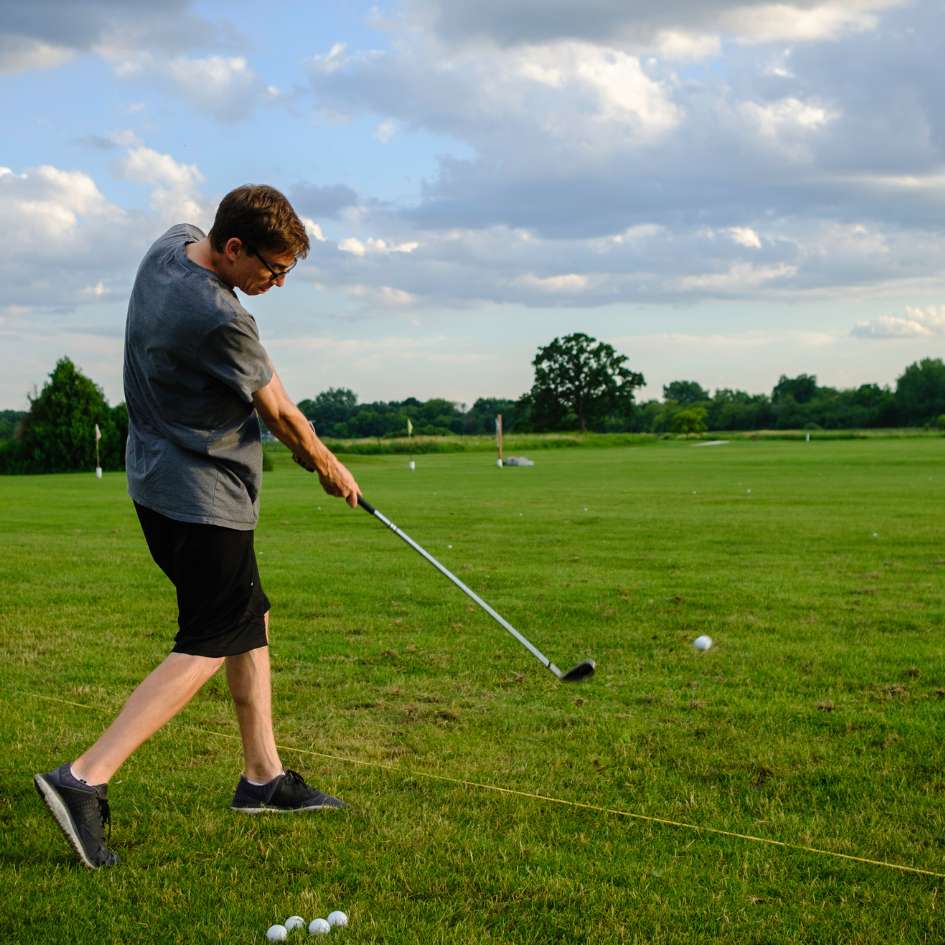
Addressing Common Swing Flaws
Identifying and addressing common swing flaws is crucial for continuous improvement.

Slice Correction: If you’re struggling with a slice, analyze your clubface angle and swing path. Adjustments to your grip and swing plane can help correct this common issue.
Hook Reduction: For golfers battling a hook, focus on grip adjustments and swing path correction. A smoother release and controlled follow-through can help reduce unwanted hooks.
Consistent Tempo: Maintain a consistent tempo throughout your swing. Sudden changes in speed can lead to inconsistency, so practice a rhythmic and controlled motion.
Overcoming Tension: Eliminate tension from your swing by staying relaxed. Tension can hinder flexibility and fluidity, impacting the overall quality of your swing.
Enhancing Clubhead Speed: Work on increasing clubhead speed gradually. A faster clubhead contributes to greater distance, but it should be achieved through proper mechanics, not excessive force
Drills and Exercises for Improvement
Incorporate specific drills and exercises into your practice routine to target key aspects of your swing.
Swing Plane Drills: Practice swinging along the correct plane using alignment sticks or training aids. This helps ingrain the proper path for a more consistent swing.
Weight Transfer Exercises: Incorporate weight transfer exercises into your fitness routine. Strengthening key muscles contributes to a more controlled weight shift during the swing.
Balance and Stability Workouts: Improve your balance and stability with targeted exercises. A stable base enhances overall control and prevents unnecessary compensations in your swing.
Clubhead Awareness Drills: Develop a heightened awareness of your clubhead’s position throughout the swing. This awareness promotes a more deliberate and controlled swing.
Mirror Practice Sessions: Utilize mirror practice sessions to observe your swing mechanics. Visual feedback is invaluable for identifying areas that need adjustment.

Mental Approaches to Swing Improvement
The mental aspect of the game plays a significant role in swing improvement. Adopt these strategies for a positive mindset.

Visualization Techniques: Visualize successful swings in your mind before each shot. Positive visualization enhances confidence and aids in replicating desired swing patterns.
Focused Practice Sessions: Approach your practice sessions with a specific focus. Target one aspect of your swing at a time, dedicating focused effort to each improvement area.
Patience and Persistence: Understand that swing improvement takes time. Be patient with the process and celebrate small victories along the way.
Positive Self-Talk: Cultivate a habit of positive self-talk on the course. Encourage yourself, even in challenging moments, and maintain a constructive internal dialogue.
Learn from Mistakes: View mistakes as learning opportunities. Analyze each swing, identify areas for improvement, and use setbacks as stepping stones to a better golf swing.
Seeking Professional Guidance
Consider enlisting the expertise of a professional golf instructor for personalized guidance.
Private Lessons: Private lessons provide one-on-one attention, allowing the instructor to assess your unique swing characteristics and tailor recommendations for improvement.
Video Analysis: Utilize video analysis during lessons to visually dissect your swing. Seeing your swing from different angles helps identify areas that require adjustment.
Customized Practice Plans: Work with an instructor to develop customized practice plans. Targeted drills and exercises can accelerate the improvement process under professional guidance.
Regular Check-Ins: Schedule regular check-ins with your instructor to track progress. Consistent feedback and adjustments contribute to ongoing improvement.
Utilizing Golf Technology: Leverage golf technology, such as swing analysis apps and launch monitors, during lessons. These tools provide valuable data for pinpointing areas of improvement.
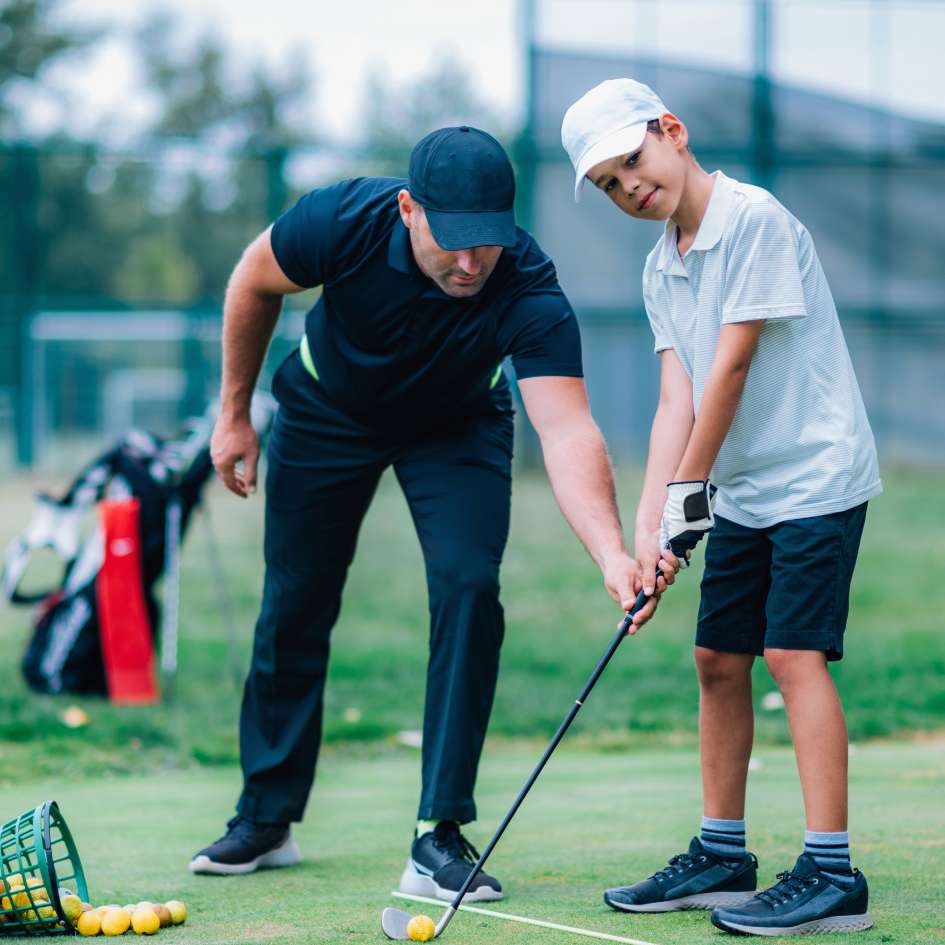
Ready to Take the Next Step? ⛳️
If you’re eager to dive deeper into golf’s intriguing world and master the ins and outs of the game, look no further than our “Golf For Beginners – The Ultimate Starter Guide.” Whether you’re a newbie or just brushing up on your skills, this online course has something for everyone.
⛳️ Discover the Ultimate Golf Starter Guide Right Here ⛳️
Conclusion: Your Journey to Swing Mastery
Congratulations! You’ve navigated through our comprehensive guide on how to improve your golf swing. Whether you’re a novice or seasoned player, continuous improvement is a shared goal in the golfing community. Apply these strategies, stay dedicated to your practice, and revel in the evolving experience of becoming a skilled and confident golfer. Golf For Beginners Academy is here to support you every step of the way. Happy swinging!
Recent Comments
Copyright @ 2024 - Golf For Beginners Academy

